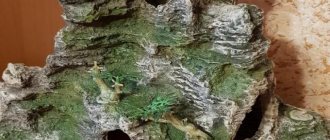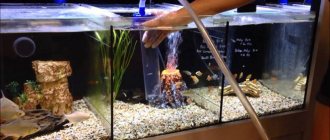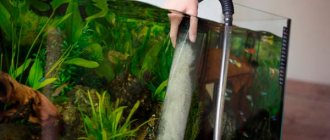In an aquarium where fish live, decorations play an important role. In addition to plants, you can add decorative elements to it: a model of a sunken ship, stones, shells and bright colorful algae. There is decor that is also functional, for example, in caves fish can hide from restless fellows. To make the design original and unique, you can make a grotto for the aquarium with your own hands.
In addition to plants, you can add decorative elements to the aquarium: a model of a sunken ship, stones, shells and bright colorful algae.
Necessary materials
If you have decided to make the decorations yourself, then first of all you need to pay attention to the materials. They must be safe and not change the aquatic environment, because many fish react very painfully not only to temperature, but also to the acidity, hardness and chemical composition of the water. Here are the basic rules:
- Materials containing lime should not be used. It increases the acidity of the water and makes it unsuitable for many fish. Cement should not be used for the same reason.
- Materials with a high iron content are also highly undesirable.
- Using stones from industrial areas or those picked up near businesses, busy highways and landfills is a very bad idea. They may contain traces of heavy substances that will not be removed even after boiling.
- There should be no sharp corners or edges, because the fish may get hurt. Even a small hole with sharp edges can cause harm if the fish does not calculate its strength and tries to squeeze through it.
- If the parts are made of wood, then you should find out in advance about the type of wood: some can release harmful substances into the water, for example, oak.
- Only special sealant for aquariums can be used as glue; the rest contain harmful substances that spoil the water.
Before starting construction, the stones and other materials from which the building will be constructed must be boiled. This kills most of the bacteria harmful to fish. Boil for at least 10 minutes; stones that have burst after this cannot be used.
It is also important to decide on the size of the cave: it directly depends on the size of the inhabitants of the aquarium. There should be enough space inside the grotto so that the fish can turn around and not get stuck in it, or the entrances should be through.
A few words about the scenery
When starting to build “houses”, take care of the environmental friendliness of the source materials. To fasten the elements, it is allowed to use only silicone intended for sealing aquariums - the rest can poison the fish.
Read also: Based on real events
Natural material collected in the natural environment requires good washing, or better yet, boiling.
Aquarium decorations should not have sharp edges, protrusions or edges. This is especially true for entrances to underwater structures, where the likelihood of fish being injured is greatest.
The internal dimensions of the premises must be sufficient for the fish to turn around or have an “emergency exit” located directly opposite the entrance.
Decorations made of pebbles
The easiest option is to make a grotto out of stones for your aquarium with your own hands. Flat river pebbles will do. You just need to glue the stones together in random order to make a small hemisphere. For convenience, you can put something underneath, for example, a toilet paper roll. It will act as a frame that will support the stones in the desired shape until the glue dries. This takes about a day.
The main difficulty here is that you need to glue the first layer of stones directly to the bottom of the aquarium, because the grotto must stand motionless under water, otherwise it will simply fall apart. If the stones are heavy enough, then you don’t have to do this. It should be taken into account that the bottom will still be covered with a layer of soil, so the entrance must either be located above the ground level, or be large enough for the fish to swim inside.
To be on the safe side, you can place the grotto in an aquarium without fish for several days, periodically changing the water. This will help flush out any remaining harmful substances from the materials and check the strength of the structure.
There is another way, but it requires the use of a drill. You will need a stone of a suitable size to drill a fish cave in it. The advantage of this option is that there is no need to glue it to the bottom; there is nothing there to fall apart even when moving. But there are also disadvantages - you need minimal skills in working with drills, a correctly selected stone (not only in size, but also in material, because not everyone can be drilled just like that) and a lot of patience. There will be a lot of noise and dust during operation.
Choosing a grotto depending on the fish
The choice of a grotto for an aquarium depends on the types of fish, since different types of aquatic inhabitants have different preferences regarding the places in which they are ready to live. Recommendations for choosing a shelter:
- Catfish need a wooden niche or large piece of driftwood to hide under. It is recommended to take branches or roots of linden, pear, apple or grapevine. They should be wide and form something like a quiet backwater, so that adult individuals lay eggs in it, and then the offspring will grow there. In addition, moving along the trunk, the catfish collects particles that improve its digestion.
- For viviparous fish (swordtails, guppies and mollies) wide houses with small entrances are needed. In them, females can calmly reproduce and raise offspring. A good shelter option is coconut halves, a grotto in the shape of a ship with a wide and hollow deck, or a cave.
- Labyrinth fish (lalius, cockerels, gouramis) during the period of preparation for offspring become too aggressive and attack everyone who approaches their home. Therefore, to separate family and neighbors, you need to install several grottoes in the aquarium, and the shapes and sizes of the structure should be different.
- For goldfish that grow to large sizes and love to spin around in numerous holes and structures, a flat castle with wide and varied arches is best suited. A good option would be arches glued together from small stones.
Important! It is worth considering that the grotto should not occupy more than 30% of the space in the aquarium.
Wooden buildings
The wood craft option is also not bad, but it is more complicated. First you need to select a small stump or driftwood without signs of rotting, clear the bark and drill holes in it for fish. One big one or many small ones - depends on the design. You can even drill out figured ones.
Then you need to sand the edges so that the fish does not harm itself . This should be done throughout the entire depth of the hole. Then burn the wood with a gas torch or blowtorch, so as not to set it on fire, you need to know how to do it correctly. To prevent the wooden grotto from starting to float at the slightest movement of water, it is glued to the base and sprinkled with soil.
Wooden tower
You can also build a wonderful grotto for an aquarium with your own hands from driftwood or a small stump. The main thing is not to take oak, which tints the water and releases unnecessary phytoncides into it. And make sure that the material is not rotten. It is also a good idea to treat the workpiece with special agents that prevent rotting. The technology is elementary: in accordance with one’s ideas about beauty, but taking into account the size of the fish living in the aquarium, passages and halls are cut out inside the wood. All places that the knife touched are scorched with a candle or a blowtorch: this will give it a natural look and will become an additional insurance against injuries.
Original grotto from a bottle
An excellent grotto can be made from a glass bottle. The volume is selected depending on the size of the pets, then the bottle must be thoroughly washed with hot water. After this you will have to cut it, this is done like this:
- First you need to prepare a container with cold water (the colder the better), some rough thread, some gasoline and a match or lighter, and fine sandpaper.
- The thread is soaked in gasoline and wrapped around the bottle in the right place. You can position it at an angle, it all depends on your imagination. Then set it on fire.
- Immediately after the thread burns, lower the bottle into cold water. Exactly where the thread was, the bottle will crack due to the temperature difference.
- All that remains is to process the edges with a file or sandpaper so that they are not sharp, but rounded.
In general, after this the glass grotto is ready. But to make it look beautiful and original, you can glue decorative elements. As an option, coat the outer edges of the bottle with aquarium glue, and sprinkle coarse sand, small pebbles, shells, algae and anything else that comes to mind on top. The finished product should dry for at least a day. In the aquarium, you will need to sprinkle the structure a little with soil so that it does not roll around.
Care
After placing the shelter in the aquarium, it is necessary to care for it. It is recommended to clean the water house from waste once a month and remove dirt from the soil under the decorative structure with a siphon. To properly clean the grotto, it will be enough to immerse it in hot water for a while. Experts do not recommend using household chemicals to wash the structure, since there is a high risk of poisoning aquatic life with chemicals.
If you liked the article, leave comments and share a link to it on social networks.
Clay crafts
If possible, you can make a grotto from red clay. This method is the most labor-intensive of all, because the clay must be fired, otherwise the product will simply break.
So, first you need to build a cave of a suitable shape. For example, in the form of a pot with a broken side or just a rectangular house. To make it spherical, you can use a balloon: inflate it to the desired size, cover it with a layer of clay (not too thin), let it dry and carefully deflate the ball, being careful not to crumple the edges of the clay sphere.
Then the product must be dried. This can be done in the sun or in the microwave. After this, firing is required. If there is a workshop with a muffle furnace nearby, then you can go there. If not, then you will have to use an oven preheated to 220 degrees. It is better to leave the door ajar. Firing takes about an hour, after which the temperature gradually decreases over 15-20 minutes . If you turn off the oven immediately, the clay will become brittle.
After firing, you can place the product next to the fish. If you decide to paint it, you need to make sure that the paints are non-toxic and will not poison the water. It is advisable to additionally burn purchased shards to kill microbes.
The clay grotto is the most labor-intensive of all, because the clay must be fired, otherwise the product will simply break.
Do-it-yourself grottoes for an aquarium - preparing a shelter
Made of wood
A wooden shelter is easy to create: a hole is cut out in a piece of wood of the required size. Then the edges of the entrance are polished to avoid injury to the fish, and firing with a blowtorch will help prevent rotting processes. You should choose wood species that do not release harmful substances into the water.
A wooden grotto for an aquarium requires additional fixation, so aquarists attach the decoration using special cement or glue it to the bottom of the tank.
From stones
Stones are a simple material for making a shelter for fish. There are two ways to make a grotto for an aquarium with your own hands
from stones:
Fortress on a rock. Aquarium grottoes. DIY aquarium grotto. Aquarium experiment
- To create, you will need flat, smooth stones, such as pebbles and aquarium silicone. The stones are glued on top of each other, creating a hemisphere. You should not carefully adjust the pebbles - negligence will give the decoration a natural look. It is important to note that this method has disadvantages, since the shelter will have to be built directly in the tank, and the bottom of the structure will be glued to the glass of the tank.
- The second method is more labor-intensive, but does not require the use of glue. To build a large grotto, you will need a large stone, in which a hole is made using a drill - an entrance for fish. Place a homemade shelter on the ground in the aquarium.
Before use, the stones should be washed and boiled.
From clay
Clay modeling is a fascinating hobby that can bring not only pleasure, but also benefit to aquarium inhabitants. For production, red clay is required, from which you can build a ship, a cave, and various other figures. How to do
clay shelters:
- A shelter of the required shape is molded from a piece of red clay: a ship, a cave or a tunnel.
- The prepared decoration is left to dry in the sun for 3-5 days.
- The product is fired in a special oven. If you don’t have one, you can burn the decoration in an oven at 220C for an hour. In this case, it is recommended to keep the door slightly open, and after finishing the firing, reduce the temperature gradually. If you take out the product right away, the clay will be brittle and break.
READ DIY small house for a kitten
Other simple options
Perhaps the easiest way is to make a cave out of coconut. You need to buy a fresh fruit, drain the milk from it, clean out the pulp and make entrances. You can leave the hairs. It is advisable to boil the new house.
Another simple way is to take a plastic bottle, cut off the neck, coat it with aquarium glue and roll it in sand or pebbles. Particular attention should be paid to the edges. To make it stable, you need to glue heavy pebbles around the edges or pour some directly inside. This option is especially good when you need to make a house in a hurry. However, you should remember that the glue must dry completely before immersing the craft in water.
Thus, making aquarium grottoes with your own hands is not at all difficult. It is only important to find environmentally friendly materials and use your imagination.
Woody grotto
Such an aquarium interior item can be made by any aquascaper using available materials. For this, stump is used, peeled and sanded on the outside. These actions are mandatory so that the structure itself does not cause bodily harm to the fish. Next, you need to use a drill to drill a wide hole inside the stump, according to your own creative plan, and the decorating grotto is ready!
Also, many aquarists, in order to protect their pets, burn the stump with a torch or blowtorch, then the edges of the structure become smoother.
This option for making a grotto in the end result looks natural and organic. It can be glued to the bottom of the aquarium or attached to a base you made yourself and sprinkled with substrate.
Errors
Errors in the manufacture of structures are usually associated with incorrect selection of materials and poor quality disinfection.
Limestones are used for grottoes in soft water aquariums with medium/low pH. The composition of the environment is dangerous for the inhabitants.
- Non-aquarium sealant was used to glue the structures together. Materials not intended for aquariums are dangerous due to the release of toxins.
- The elements have not been boiled or have not been washed properly. Risks infection and parasites.
- Detergents were used. Risks of fish poisoning.
Finished goods
Decorations are chosen differently: according to shape, size, color scheme. When selecting, you need to take into account that a small grotto will get lost in a large aquarium, so the size must be appropriate. Most offers from specialized outlets include clay options, which have many advantages.
However, we must not forget about the forms. There are several that are most popular among consumers. Among them are a grotto-ship, a grotto-castle, a grotto-rock and a grotto-skull.
A ship-shaped grotto can often be seen among aquarists. It usually looks like a sunken pirate ship that has broken into several pieces. Most often there are quite a lot of compartments where fish can hide. In addition, it is in it that you can hide the sprayer from the air compressor, which often negatively affects the appearance of the composition.
The grotto in the form of an underwater castle looks simply fabulous. It seems that the aquarium houses a real marine kingdom.
The grotto rock is intended for those who love naturalness. Aquarists often place live plants next to it, and the grotto
looks like part of the natural landscape.
And finally, lovers of unusual and mysterious decor will love the skull-shaped grottoes. Some people prefer to throw a few coins, pre-coated with waterproof varnish, to the bottom. They will help create a brighter ambience and decorate the composition.
From clay
When the desired shape is formed, the mainsail needs to be dried. The process takes from 3 days to a week. If the product is wet, it will crack during firing. When working at home, an oven is used for firing, which is gradually heated to approximately 250 degrees. There is no need to rush in such a situation. Firing time – up to 6 hours.
Cooling the mainsail quickly is also not recommended. First it must cool in the oven, after which it is removed, rinsed with water and placed in the aquarium
.
Stone decorative structures
The simplest option is to create a small grotto using small pebbles, and flat river pebbles are suitable for this.
You can make a frameless shallow grotto by sequentially gluing stones to each other in such a way as to gradually, row by row, create a small hemisphere with an open entrance. And even if the shape of the fish shelter is irregular, this will even emphasize its naturalness.
There are several conditions:
- stones should not have sharp edges,
- The construction of the structure should be done directly in the aquarium, before filling it with water.
The result is a natural, functional and fish-safe part of the overall decor, the only drawback of which is the need to glue the very first row of stones directly to the bottom glass of the aquarium.
The mainsail must remain stationary to avoid damage. Yes, the pebbles must first be boiled.
There is another way - a very labor-intensive one. A stone of the appropriate size is selected, in which a fish cave is gradually drilled using drills of various diameters. The work is dusty, noisy and difficult, but such a grotto has its advantages.
- Firstly, there is no need to use glue and paint.
- Secondly, such a solid “cave” can be installed anywhere.
However, you should not place the cobblestone on the glass; It is better to carefully lay it on the ground to evenly distribute the load.
Shopping is a joy
Today, pet stores and Internet sites offer a variety of artificial grottoes. The buyer will find them for any aquarium, ranging in size from 5 cm to a meter. A wide selection of shapes, colors and materials are available.
The decor in the aquarium is selected according to the designer’s idea or following an instant impulse. The first places come out to be ships and chests, usually associated with pirates and shipwrecks. I add mystery to the castles and towers, and the skulls have a slightly darker style. Not only fish can hide in these grottoes, but also compressors and filters can be disguised.
Options that are close to natural shelters: rocks, branches, corals, heaps of pebbles will help create the effect of a sea or river bottom. Especially if you plant algae correctly and decorate the glass bottom.
The leading position is occupied by grottoes made of ceramics, which are heavy enough to stand on the bottom, non-toxic and durable.
Separately, there is an artificial grotto made of plastic and plastic. Scientists have proven that they contain harmful additives that poison the water and cause illness in fish. Therefore, you should carefully read the composition and recommendations on the product description. Such decorations are often made for completely artificial aquariums, in which even the fish are plastic.











